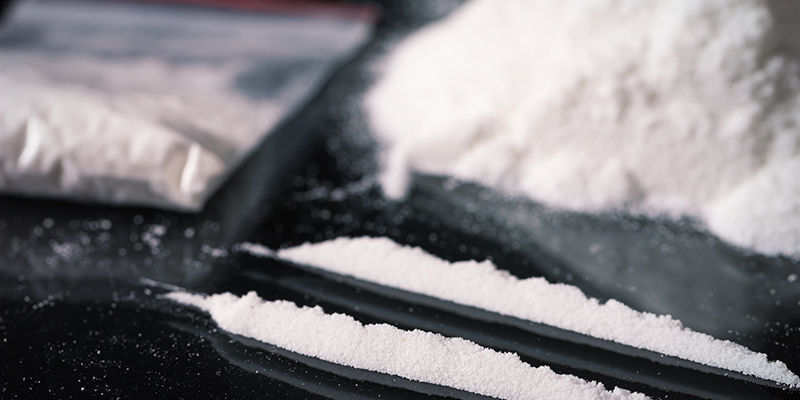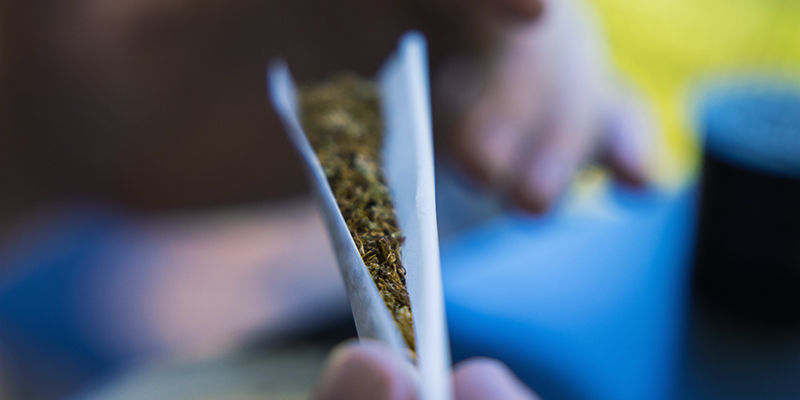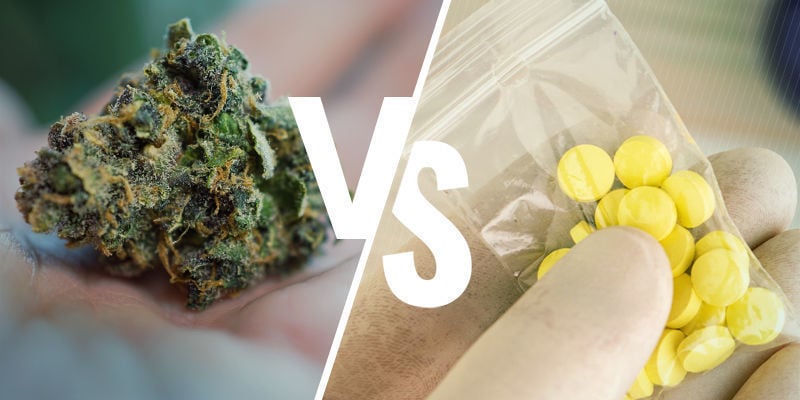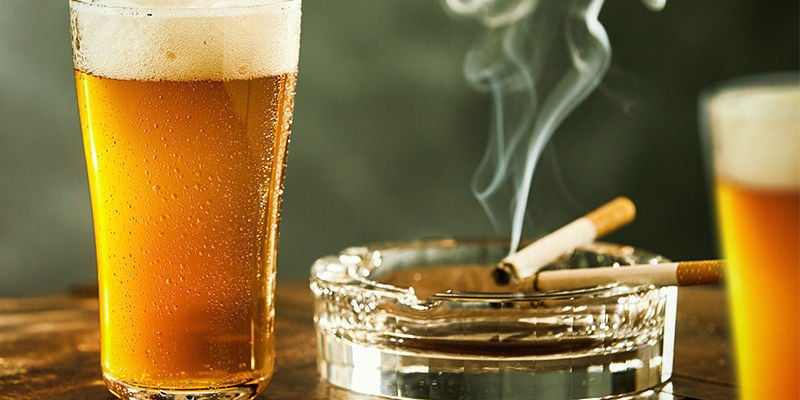
What’s The Difference Between Hard And Soft Drugs?
Ask someone if they know how to distinguish between hard and soft drugs, and they'll likely say yes. However, just how effective are the terms "hard" and "soft" in classifying drugs and their effects? We take a dive into the classifications, and consider the validity of our current methods of distinguishing substances.
“Hard” and “soft” are vague terms used to describe different drugs based on their perceived health impact, addiction potential, highs, and more. But do these terms really give us a clear understanding of different drugs and their effect on our health? Keep reading to find out.
The classification of hard and soft drugs

Whether it’s by the public, the media, the scientific community, or even government officials, "hard" and "soft" get thrown around a lot. And while most of us think we know what is meant by these terms, making a concrete distinction between the two isn't so simple.
In fact, not even global health authorities such as the International Classification of Diseases (ICD) nor the Diagnostic and Statistical Manual of Mental Disorders (DSM) make clear distinctions between hard and soft drugs. One of the few entities to draw a clear line between hard and soft drugs is the Dutch government, which uses the terms "hard" and "soft" in its drug legislation.
Nonetheless, most people would agree that they have at least some understanding of what classifies as a hard or soft drug, despite there being no formal definitions. Below, we take a closer look at what distinguishes hard and soft drugs, and examine the validity of drug classifications in general.
What are hard drugs?

Ask someone whether they know what a “hard drug” is and they’ll likely nod in agreement. For years, governments and the media have pushed the idea that hard drugs are more potent, more addictive, and more dangerous than their soft counterparts. In reality, however, whether a drug is hard or soft largely comes down to its potential to cause physical harm and addiction/dependency in users.
While the hard/soft classification is considered evermore outdated, it is, unfortunately, still used across the globe.
Examples of hard drugs
- Cocaine and crack
- Heroin and opium
- Crystal meth and amphetamines
- PCP
- Ketamine
- Opioids, benzodiazepines, and other prescription drugs
- Ecstasy
- Alcohol and tobacco
- LSD and magic mushrooms (often defined by law as hard, though many argue unjustly)
What are soft drugs?

Whereas hard drugs are considered to be extremely potent, dangerous, and addictive, soft drugs are considered to be far less harmful. Generally speaking, people consider soft substances to be those that present a slim chance of causing physical harm, dependence, or addiction. Again, the Dutch government makes clear mention of some soft drugs in its Opium Act (mainly cannabis and sleeping pills/sedatives), but what people consider to be soft drugs varies across the globe.
Examples of soft drugs
- Cannabis and cannabis derivatives
- Sleeping pills and sedatives (in the Netherlands)
Natural vs synthetic drugs

Just like many people have firm opinions on what constitutes a hard or soft drug, many people also believe that whether a drug is natural or synthetic says something about its potential to harm users. After all, if it grows in the ground, it’s probably okay, right?
Unfortunately, assuming a drug is safe because it is natural is hardly a sound argument. Cocaine and opium (and their variants/derivatives) both come from natural sources, namely the coca plant and the opium poppy, respectively.
However, both substances have a high potential for addiction and can be fatal in high doses. Alcohol and tobacco are also hard drugs (surprise, surprise) that are derived from completely natural ingredients. As we’ll discuss later on, terms like hard, soft, natural, and synthetic aren’t really effective ways to classify substances or consider their safety and health impact.
The difference between hard and soft drugs
Besides their potential to cause harm and addiction, drugs are also distinguished by how they’re consumed, the effects they produce, the legislation governing/prohibiting their use/commercialisation, and their availability.
With that in mind, let’s take a closer look at some of the differences between hard and soft drugs. Keep in mind that these ideas aren’t set in stone, but rather represent a general way of thinking about the differences between substances.
Consumption

Because hard drugs are considered to be more harmful, people often perceive that their use differs dramatically from that of soft drugs. Multiple online resources, as well opinion polls, show that people tend to believe that hard drugs are used in excess, with less control and a higher risk of misuse than soft drugs.
For example, when people think of cannabis use, they often imagine someone casually smoking a joint, be it at home in front of the TV or at a party/gathering with friends. On the other hand, the use of hard drugs like cocaine or methamphetamines is often associated with long, out-of-control benders that can last well into the next day (or several days).
While the consumption of different drugs obviously varies, this doesn’t necessarily come down to whether or not they are hard or soft substances. It’s important to remember that different drugs appeal to different people, and are therefore accompanied by different cultures. Cannabis culture, for example, is completely different from the culture surrounding alcohol use, cocaine, or party drugs like amphetamines and ecstasy.
Effects
In general, people associate hard drugs with stronger, more mind-altering effects than soft drugs. Again, this is a misconception.
For example, there are multiple hard drugs that produce fairly mild effects. Tobacco is both a highly toxic and addictive substance, yet its effects are considered mild. Cannabis, on the other hand, produces far more intense, mind-altering effects, yet is considered a soft drug by some governments and institutions.
Legality

Numerous Western countries make legal distinctions between hard and soft substances in their drug legislature. In most cases, the use or possession of soft drugs is subject to laxer laws than that of hard drugs.
Using our earlier example, the Dutch government makes very clear distinctions between soft drugs (cannabis, sleeping pills, and sedatives) and hard drugs (cocaine, heroin, LSD, magic mushrooms, ecstasy, and prescription opiates/benzodiazepines). In fact, under the Dutch tolerance policy, the sale, use, and possession of small amounts of cannabis in coffeeshops is tolerated and not penalised, despite the fact that cannabis is still considered an illegal substance under Dutch law.
Availability
As the perception of drug culture changes, many other countries around the world are beginning to amend their policies regarding soft drugs and allowing/tolerating their use, such as:
-
Uruguay, which has completely decriminalised cannabis use and makes it available for purchase to registered citizens via pharmacies.
-
Canada, which has completely legalized the adult use of cannabis.
-
The United States, where 19 states and counting have legalized recreational cannabis, and many others have allowed for medical use.
-
Mexico, which now allows the possession of small amounts of cannabis.
What are gateway drugs?

Gateway drugs are those considered to encourage harder, more dangerous drug use. There are essentially three substances under the gateway drug designation: alcohol, nicotine, and marijuana. Though this is certainly true of the first two substances, many believe cannabis is not worthy of this designation. In fact, a 2018 review by the National Institute of Justice analysed 23 peer-reviewed human and animal studies linking marijuana use to harder drug use down the line. Ultimately, they concluded that “there is currently no conclusive evidence that cannabis use caused the later use of harder illicit drugs”[3].
Should we classify drugs this way?
Classifying drugs as hard or soft is far from ideal. As we saw in this article, and as discussed in a 2017 scientific review published in the American Journal of Drug and Alcohol Abuse, this type of classification is based more on our individual perception of different drugs than their actual effects on our health. Alcohol and cigarettes are prime examples of hard drugs that are deeply ingrained and accepted in Western culture, whereas LSD and psilocybin are perfect examples of drugs considered to be “hard” in certain places, but actually have very few health risks and low addiction potential.
- (n.d.). Government of The Netherlands. Difference between hard and soft drugs(s). https://www.government.nl/topics/drugs/difference-between-hard-and-soft-drugs. Accessed 5.11.2021. - https://www.government.nl
- (n.d.). McVean, Ada. Caffeine is considered a hard drug and cannabis a soft one? McGill Office for Science and Society: Separating Sense from Nonsense. Published 29.11.2017. https://www.mcgill.ca/oss/article/did-you-know/what-makes-hard-drugs-hard-and-soft-drugs-soft. Accessed 5.11.2021. - https://www.mcgill.ca
- (n.d.). Is Cannabis a Gateway Drug? Key Findings and Literature Review. National Institute of Justice. https://nij.ojp.gov/library/publications/cannabis-gateway-drug-key-findings-and-literature-review. Accessed November 10, 2021. - https://nij.ojp.gov
- Janik P, Kosticova M, Pecenak J, & Turcek M. (2017 Nov). Janik, Peter, Kosticova Michaela, Pecenak, Jan, & Turcek, Michal. Categorization of psychoactive substances into 'hard drugs' and 'soft drugs': a critical review of terminology used in current scientific literature. American Journal of Drug and Alcohol Abuse. 2017; Volume 43 (6): 636-646. https://pubmed.ncbi.nlm.nih.gov/28650668/. 5.11.2012 - https://pubmed.ncbi.nlm.nih.gov
-
 4 min
February 16, 2023
How To Recover From An MDMA Hangover
MDMA is famed for the glowing feelings it produces on a night out, but it can make you pay for them with a nasty hangover. Luckily, if you know how what to do, it’s possible to get right back on...
4 min
February 16, 2023
How To Recover From An MDMA Hangover
MDMA is famed for the glowing feelings it produces on a night out, but it can make you pay for them with a nasty hangover. Luckily, if you know how what to do, it’s possible to get right back on...
-
 8 min
July 16, 2020
LSD 101: An Overview
A comprehensive guide on LSD for anyone looking to gain a first impression of the drug. We cover LSD’s discovery and history, and its impact on art and culture. You will learn about the effects of...
8 min
July 16, 2020
LSD 101: An Overview
A comprehensive guide on LSD for anyone looking to gain a first impression of the drug. We cover LSD’s discovery and history, and its impact on art and culture. You will learn about the effects of...
-
 3 min
February 9, 2020
What Is Tripping On DMT Really Like?
DMT is a psychoactive compound known to produce intense auditory and visual hallucinations. When consuming DMT, many people feel as though they have left their body, the world, or have entered...
3 min
February 9, 2020
What Is Tripping On DMT Really Like?
DMT is a psychoactive compound known to produce intense auditory and visual hallucinations. When consuming DMT, many people feel as though they have left their body, the world, or have entered...
-
 5 min
August 1, 2018
The MDMA Jaw Clench: What It Is And How To Stop It
Reducing MDMA jaw clench involves a combination of preemptive planning and dietary supplements.
5 min
August 1, 2018
The MDMA Jaw Clench: What It Is And How To Stop It
Reducing MDMA jaw clench involves a combination of preemptive planning and dietary supplements.











 United States
United States








